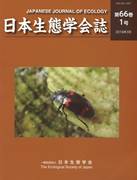6 巻, 4 号
選択された号の論文の28件中1~28を表示しています
- |<
- <
- 1
- >
- >|
-
原稿種別: 表紙
1957 年 6 巻 4 号 p. Cover1-
発行日: 1957/03/15
公開日: 2017/04/07
PDF形式でダウンロード (60K) -
原稿種別: 表紙
1957 年 6 巻 4 号 p. Cover2-
発行日: 1957/03/15
公開日: 2017/04/07
PDF形式でダウンロード (60K) -
原稿種別: 付録等
1957 年 6 巻 4 号 p. App1-
発行日: 1957/03/15
公開日: 2017/04/07
PDF形式でダウンロード (80K) -
原稿種別: 本文
1957 年 6 巻 4 号 p. 133-137
発行日: 1957/03/15
公開日: 2017/04/07
PDF形式でダウンロード (841K) -
原稿種別: 本文
1957 年 6 巻 4 号 p. 137-140
発行日: 1957/03/15
公開日: 2017/04/07
PDF形式でダウンロード (600K) -
原稿種別: 本文
1957 年 6 巻 4 号 p. 141-144
発行日: 1957/03/15
公開日: 2017/04/07
PDF形式でダウンロード (595K) -
原稿種別: 本文
1957 年 6 巻 4 号 p. 145-149
発行日: 1957/03/15
公開日: 2017/04/07
PDF形式でダウンロード (704K) -
原稿種別: 本文
1957 年 6 巻 4 号 p. 149-152
発行日: 1957/03/15
公開日: 2017/04/07
PDF形式でダウンロード (684K) -
原稿種別: 本文
1957 年 6 巻 4 号 p. 153-155
発行日: 1957/03/15
公開日: 2017/04/07
PDF形式でダウンロード (478K) -
原稿種別: 本文
1957 年 6 巻 4 号 p. 156-159
発行日: 1957/03/15
公開日: 2017/04/07
PDF形式でダウンロード (607K) -
原稿種別: 本文
1957 年 6 巻 4 号 p. 159-162
発行日: 1957/03/15
公開日: 2017/04/07
PDF形式でダウンロード (649K) -
原稿種別: 本文
1957 年 6 巻 4 号 p. 162-165
発行日: 1957/03/15
公開日: 2017/04/07
PDF形式でダウンロード (599K) -
原稿種別: 本文
1957 年 6 巻 4 号 p. 165-170
発行日: 1957/03/15
公開日: 2017/04/07
PDF形式でダウンロード (969K) -
原稿種別: 本文
1957 年 6 巻 4 号 p. 170-173
発行日: 1957/03/15
公開日: 2017/04/07
PDF形式でダウンロード (788K) -
原稿種別: 本文
1957 年 6 巻 4 号 p. 173-176
発行日: 1957/03/15
公開日: 2017/04/07
PDF形式でダウンロード (638K) -
原稿種別: 本文
1957 年 6 巻 4 号 p. 177-180
発行日: 1957/03/15
公開日: 2017/04/07
PDF形式でダウンロード (623K) -
原稿種別: 本文
1957 年 6 巻 4 号 p. 180-184
発行日: 1957/03/15
公開日: 2017/04/07
PDF形式でダウンロード (823K) -
原稿種別: 本文
1957 年 6 巻 4 号 p. 184-189
発行日: 1957/03/15
公開日: 2017/04/07
PDF形式でダウンロード (1039K) -
原稿種別: 本文
1957 年 6 巻 4 号 p. 189-191
発行日: 1957/03/15
公開日: 2017/04/07
PDF形式でダウンロード (539K) -
原稿種別: 本文
1957 年 6 巻 4 号 p. 191-
発行日: 1957/03/15
公開日: 2017/04/07
PDF形式でダウンロード (215K) -
原稿種別: Article
1957 年 6 巻 4 号 p. 191-
発行日: 1957/03/15
公開日: 2017/04/07
PDF形式でダウンロード (215K) -
原稿種別: Article
1957 年 6 巻 4 号 p. 192-
発行日: 1957/03/15
公開日: 2017/04/07
PDF形式でダウンロード (196K) -
原稿種別: 本文
1957 年 6 巻 4 号 p. 192-
発行日: 1957/03/15
公開日: 2017/04/07
PDF形式でダウンロード (196K) -
原稿種別: 本文
1957 年 6 巻 4 号 p. 192-
発行日: 1957/03/15
公開日: 2017/04/07
PDF形式でダウンロード (196K) -
原稿種別: 付録等
1957 年 6 巻 4 号 p. 192-
発行日: 1957/03/15
公開日: 2017/04/07
PDF形式でダウンロード (100K) -
原稿種別: 付録等
1957 年 6 巻 4 号 p. App2-
発行日: 1957/03/15
公開日: 2017/04/07
PDF形式でダウンロード (62K) -
原稿種別: 表紙
1957 年 6 巻 4 号 p. Cover3-
発行日: 1957/03/15
公開日: 2017/04/07
PDF形式でダウンロード (75K) -
原稿種別: 表紙
1957 年 6 巻 4 号 p. Cover4-
発行日: 1957/03/15
公開日: 2017/04/07
PDF形式でダウンロード (75K)
- |<
- <
- 1
- >
- >|
